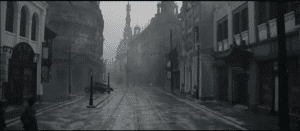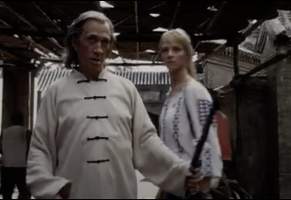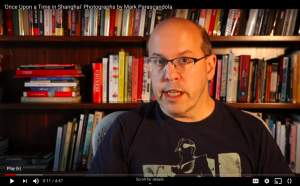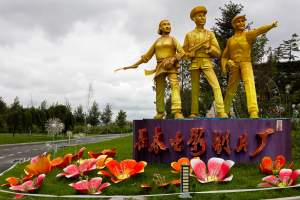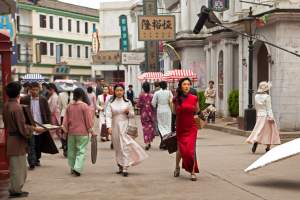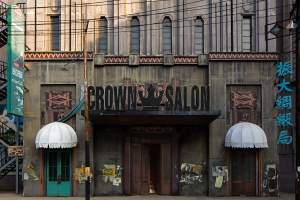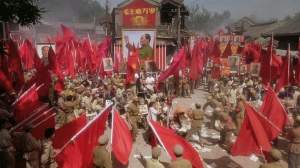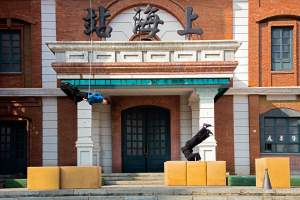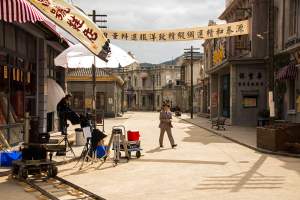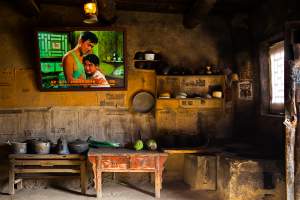Category: China Film
Shanghai Film Studio’s ‘Nanjing Road’
If you’ve seen a film or TV show set in period Shanghai, you’ve probably seen this three block long stretch of 1930s-era Nanjing Road. Originally constructed with Taiwanese financing for Chen Kaige’s “Temptress Moon” in 1995, it’s been reused for numerous films from Ang Lee’s “Lust, Caution” to future science fiction film “Looper.” I created a brief video retrospective on the many lives of this movie set. Click on the viewer above to watch.
Read More‘Kill Bill’ at the Beijing Film Studio
In 2002, Quentin Tarantino filmed parts of Kill Bill at the historic Beijing Film Studio. The House of Blue Leaves, where Beatrix “The Bride” Kiddo (Uma Thurman) has a blood-splattering showdown with the Crazy 88, was constructed on a soundstage here. But the only scene to use exterior sets on the studio’s back lot was cut from the final edit. In this now infamous scene, Michael Jai White (with fake New Zealand accent) and his gang confront Bill (David Carradine) while he is out for a casual stroll with his disciple. Bill begrudgingly accepts the challenge while Kiddo watches from […]
Read MoreBook Video: Once Upon a Time in Shanghai
When the Capitol Hill Book Fair was moved virtual this spring, I put together this 5 minute video to present my latest book ‘Once Upon a Time in Shanghai: Behind the Scenes of the Chinese Movie Industry’ (Daylight Books, 2019). I wanted to share what I find so fascinating about the mainland China film industry, as well as the process and thought that went into making the photographs. Understanding the oversized movie production infrastructure in China seems even more relevant now, as the COVID-19 pandemic has shut down movie production and theaters across the US. PEN America released a report […]
Read MoreChangchun Film Studio
The Changchun Film Studio was the first official state-run film studio recognized in the People’s Republic of China. It was created through merging multiple existing film production facilities and, in 1955, was given a permanent home in Changchun. For several decades, the studio occupied a cluster of buildings which had been constructed under the Japanese occupation to imitate the German Ufa Film Studio. The studio reportedly produced over 1000 feature films over the years. The film Bridge was made here in 1949, the PRC’s first feature film, which told the story of a worker who inspires his comrades to finish […]
Read MoreHengdian: The World’s Largest Film Studio
Xie Jin was one of the most important film directors of the Communist cinema generation working in the 1950s and early 1960s. His 1965 film Two Stage Sisters would later go on to receive international acclaim, but at the time, at the start of the Cultural Revolution, it was attacked for purportedly promoting bourgeois values. Xie was eventually rehabilitated and went on to make other important films, including Legend of Tianyun Mountain and Hibiscus Town. In 1995, Xie, now in his 70s, was scouting locations for a State-supported historical epic titled The Opium War. With a budget of $15 million, […]
Read MoreRepublic of China on Taihu Lake
The awkwardly named ‘Jiangsu West Taihu Lake Film and Television Industry Base‘ in Changzhou, northwest of Shanghai, is relatively new, established in 2015. It reportedly cost over $110 million to build and includes 7 indoor sound stages and 150 acres of outdoor sets and other facilities. The site is especially known for its use in Republic of China era TV series, and most of the outdoor lot consists of streets of early 20th century urban streetscapes. The 2019 film Liberation, which received a very limited US release in January 2020, was made there, along with TV dramas Detective Ke Chen […]
Read MoreFarewell My Film Studio
The Beijing Film Studio was created in 1949 as one of the primary state-run film production facilities. The studio was responsible for classic films such as New Year’s Sacrifice (1956) and Song of Youth (1959). Later, the studio constructed a traditional Chinese streetscape on a backlot near the university district in Beijing, reportedly used for 1982 films Rickshaw Boy and Teahouse. It also became the first studio to open up to international co-productions with Bernardo Bertolucci’s The Last Emperor in 1987, which also received permission to film within the Forbidden City. In the early 1980s, former Taiwanese film star Feng […]
Read MoreHuzhou Film and Television City
Huzhou Film and Television City, located within the Taihu National Tourism Resort, is just as much about family entertainment as it is about film production. When I visited, the entire park staff assembled out front for a song and dance routine before the doors opened. Tourist shows occur throughout the day, including an acrobatic police chase (pictured), axe gang choreography inspired by Kung Fu Hustle, and a fictional wedding ceremony. The first portion of the park, representing Republic of China era Shanghai, was constructed in 2016. It includes the Bund, a port, a Catholic church, and other large scale buildings. […]
Read MoreXiangshan Film and TV City
The Xiangshan studios opened in 2005 on an undeveloped peninsula of fishing villages south of Ningbo for The Return of the Condor Heroes (2006), based on the Wuxia novel by Jin Yong. The site was also used for Chen Kaige’s historical drama Sacrifice (2010) and for the popular TV series Nirvana in Fire (2015). A Republic of China section added later was used in the ill-fated WWII film Air Strike with Bruce Willis. The production was hampered by delays, cost overruns, and a tax evasion scandal involving actress Fan BingBing before it was widely panned by critics.
Read MoreZhenbeipu Western Film Studio
Constructed on the ruins of an old fortress outside Yinchuan in northwestern China near the edge of the Gobi desert, the Western Film Studio has been used in numerous epic historical films. Writer Zhang Xianliang first had the idea to use the site as a film location after spending time laboring on a nearby farm during the Cultural Revolution. The 1982 film The Herdsman, based on a story by Zhang, was the first feature film made here and one of the first Chinese films to get international recognition. Other noteworthy films shot here include Zhang Yimou’s Red Sorghum (1987), Hong […]
Read More